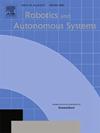High-safety path optimization for mobile robots using an improved ant colony algorithm with integrated repulsive field rules
IF 4.3
2区 计算机科学
Q1 AUTOMATION & CONTROL SYSTEMS
引用次数: 0
Abstract
This paper introduces an improved ant colony algorithm, AR-ACO (A*-Repulsive field-ACO), to enhance the efficiency of path planning for mobile robots in complex maps. This paper adopts six strategies to optimize the iterative process of the ACO algorithm and strengthen the selection of the optimal path. Firstly, inspired by the repulsive field characteristics of artificial potential fields, an Obstacle Impact Factor is introduced to identify the risk zones in the map and adjust the initial distribution of pheromones. Secondly, to ensure the global and discriminative nature of the map, a dynamic constraint is applied to pheromones, following the MAX-MIN Ant system. Thirdly, a novel backtracking mechanism is proposed to address deadlock situations and reduce computational burden. Fourthly, heuristic information in the ant colony algorithm is improved to accelerate convergence speed and enhance the smoothness of global paths. Fifthly, the evaporation factor pheromone formula has been improved to optimize the ability to cope with complex terrains. Additionally, an improved elite ant retention strategy is introduced to significantly enhance the ants' optimization capability while ensuring convergence speed. Simulation experiments and physical verifications conducted in various environments, especially in complex large-scale maps, demonstrate that the optimized algorithm outperforms traditional algorithms, confirming the effectiveness of the improved ant colony algorithm.
基于集成排斥场规则的改进蚁群算法的移动机器人高安全路径优化
为了提高移动机器人在复杂地图中路径规划的效率,提出了一种改进的蚁群算法AR-ACO (A*-斥力场- aco)。本文采用六种策略对蚁群算法的迭代过程进行优化,加强对最优路径的选择。首先,利用人工势场的排斥场特性,引入障碍物影响因子,识别地图上的危险区域,调整信息素的初始分布;其次,遵循MAX-MIN蚁群系统,对信息素进行动态约束,以保证地图的全局和判别性。第三,提出了一种新的回溯机制来解决死锁问题,减少计算负担。第四,改进蚁群算法中的启发式信息,加快收敛速度,增强全局路径的平滑性。第五,对蒸发因子费洛蒙公式进行了改进,优化了应对复杂地形的能力。此外,引入改进的精英蚂蚁保留策略,在保证收敛速度的同时显著提高蚂蚁的优化能力。在各种环境,特别是复杂的大比例图中进行的仿真实验和物理验证表明,优化后的算法优于传统算法,证实了改进蚁群算法的有效性。
本文章由计算机程序翻译,如有差异,请以英文原文为准。
求助全文
约1分钟内获得全文
求助全文
来源期刊

Robotics and Autonomous Systems
工程技术-机器人学
CiteScore
9.00
自引率
7.00%
发文量
164
审稿时长
4.5 months
期刊介绍:
Robotics and Autonomous Systems will carry articles describing fundamental developments in the field of robotics, with special emphasis on autonomous systems. An important goal of this journal is to extend the state of the art in both symbolic and sensory based robot control and learning in the context of autonomous systems.
Robotics and Autonomous Systems will carry articles on the theoretical, computational and experimental aspects of autonomous systems, or modules of such systems.
 求助内容:
求助内容: 应助结果提醒方式:
应助结果提醒方式:


